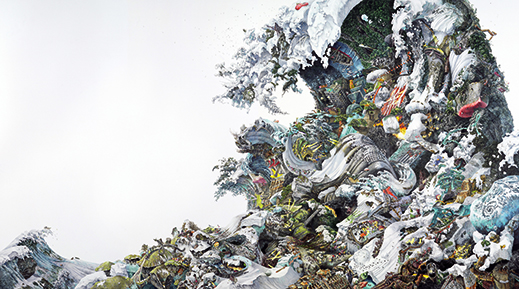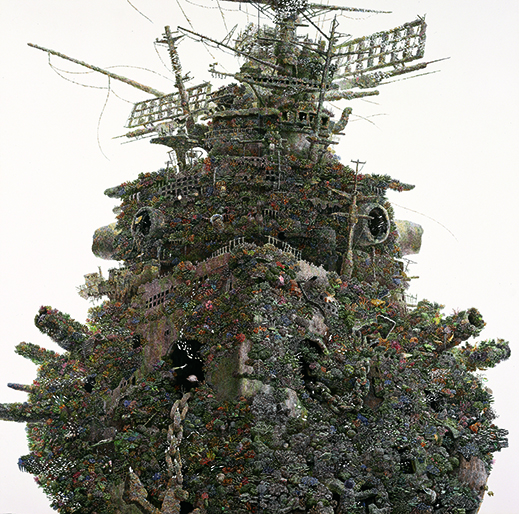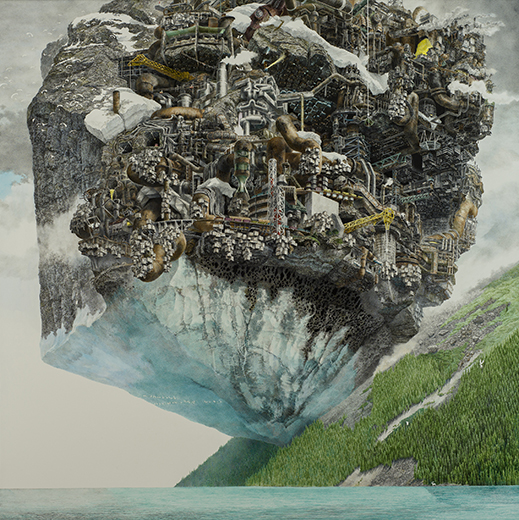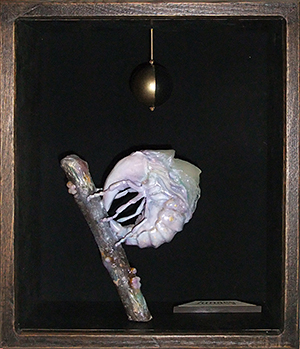 |
|
Here and There introduces art, artists, galleries and museums around Japan that non-Japanese readers and first-time visitors may find of particular interest. The writer claims no art expertise, just a subjective viewpoint acquired over many years' residence in Japan.
|
|
 |
|
|
 |
 |
In the Zone: Manabu Ikeda and Yurie Kawagoe at Kanazawa's 21st Century Museum
Alan Gleason |
 |
|
Kids gather around a clown outside the 21st Century Museum of Contemporary Art, Kanazawa. Photo by Alan Gleason |
Ever since it opened in 2004, the 21st Century Museum of Contemporary Art, Kanazawa has stood out as an architectural anomaly amid the old buildings and gardens of a city that rivals Kyoto as a bastion of traditional Japanese culture. Designed by the prizewinning architect team SANAA, the museum is a huge, flat, glass-walled white disk that resembles the Mother Ship in a sci-fi epic.
One of the facility's avowed aims was "to create a participation-oriented museum along with citizens and revitalize the community," but on my previous visit in 2009 I found myself wondering just how it would manage to integrate (or ingratiate) itself with this proudly conservative castle town. On a late-spring Sunday this year, the throngs inside and outside the building -- particularly the little kids playing and shouting amid the abstract sculptures that dot the lawn -- provided the answer.
The museum's successful romance with the citizens of Kanazawa can surely be attributed to its efforts to maximize accessibility. One example is the division of its many galleries into an Exhibition Zone and a Public Zone. The former offers special shows during typical museum hours for typical admission fees, but the Public Zone is free of charge and stays open year-round (except over the New Year) and for much longer hours. Besides a shop, restaurant, theater, library, nursery and other amenities, the Public Zone includes a number of large spaces that feature exhibitions just as stimulating as the more prominently hyped ones in the Exhibition Zone.
 |
|
Yurie Kawagoe, mating cowards (2016), mixed media, 65 x 205 x 15 cm, © Yurie Kawagoe; collection of the artist |
On that recent Sunday -- a fortuitously warm, bright day just before the rainy season kicked in -- I found a long queue of visitors buying tickets to the main exhibition of works by Manabu Ikeda. To kill time while waiting for the crowd to thin out I wandered into the Public Zone and was thrilled to discover a show in the Long-Term Project Room introducing Yurie Kawagoe, a less well-known but equally talented artist, about whom more below.
In the basement, People's Gallery B was displaying abstract paintings by 47 Japanese artists in 2017 Contemporary Art Festival Nebula in Kanazawa. But by now I needed a bit of a breather before plunging into the Ikeda show, so I wandered outside, grabbed a bite of lunch from one of the food trucks lined up by the back gate, sat on an aluminum chair that appeared to be part of an outdoor sculpture built for that purpose, and watched children swarm the artworks on the lawn while their parents looked on. I topped my picnic off with a brief doze on a bench under one of the museum's permanent installations, James Turrell's minimalist, meditative Blue Planet Sky, which consists of what you see when you look up through a big square hole cut out of the roof.
 |
|
Manabu Ikeda, Foretoken (2008), pen and ink on paper, mounted on board, 190 x 340 cm, © Manabu Ikeda. Kagura Salon / Sustainable Investor Co., Ltd.; courtesy Mizuma Art Gallery. Photo by Yasuhide Kuge |
Thus rejuvenated I returned to the ticket counter and joined the procession (now somewhat shorter) into the Exhibition Zone. Manabu Ikeda's 120-piece retrospective, The Pen -- Condensed Universe, was not merely worth the wait, it was mesmerizing. Ikeda (b. 1973) has already won international acclaim for his astonishingly detailed pen and ink work. Yet it is not so much his technique as his compositional vision and thematic worldview that give his work the mark of genius. His best-known pieces are sprawling kitchen-sink assemblages of imagery that Ikeda admits to making up on the fly -- a gnarled tree root may spontaneously turn into an octopus with tentacles, grasping a beachball that becomes the moon. He starts from scratch without any preliminary sketching, but because his process is so painstaking, he has plenty of opportunity to improvise as he goes along. It can take a full day to complete a 10-centimeter square section of a work, he says.
 |
|
Manabu Ikeda, Regeneration (2001), pen and ink on paper, mounted on board, 162 x 162 cm, © Manabu Ikeda. Hamamatsu Municipal Museum of Art; courtesy Mizuma Art Gallery |
A first-rate draftsman who once earned a living as a courtroom artist, Ikeda applies a photorealistic touch to phantasmagoric motifs. His canvases are covered with decaying cityscapes, creeping vegetation, trees that embody entire worlds, and waves that threaten to drown them. There are recurring references to impending apocalypse, though it was not always thus. Some sketches of mushrooms, broccoli, and clouds from 1999 suggest an interest in simply showing things as they are, as do the Audubon-like renderings of animals he occasionally draws to this day.
|
Manabu Ikeda, History's Rise and Fall (2006), pen and ink on paper, mounted on board, 200 x 200 cm, © Manabu Ikeda. Takahashi Collection. Photo by Kei Miyajima |
It was not until the early 2000s that Ikeda began producing the most stunning titles in his oeuvre, works that share a decidedly caustic critique of modern society. Regeneration (2001) shows a sunken, barnacle-encrusted World War II battleship with schools of fish swimming in and out of the gun barrels; History's Rise and Fall (2006) is a top-heavy mass of traditional-looking Japanese structures about to collapse in on itself; and Foretoken (2008), an eerily prescient work completed three years before the Tohoku earthquake and tsunami, is dominated by a monstrous wave sweeping up civilization's detritus in its wake. Not surprisingly, Ikeda was deeply affected by the actual earthquake and tsunami that struck in 2011. Two years later he completed Meltdown, in which a great chunk of ice, covered with rusted tanks and pipes that evoke a crumbling nuclear power plant, is on the verge of plunging into the sea.
 |
|
Manabu Ikeda, Meltdown (2013), pen and ink on paper, mounted on board, 122 x 122 cm, © Manabu Ikeda. Chazen Museum of Art; courtesy Mizuma Art Gallery |
That same year Ikeda was invited to take up residence in Madison, Wisconsin, where the Chazen Museum of Art commissioned him to create a work on-site (he still lives in Madison). Completed in 2016, Rebirth is the centerpiece of the current show. The artist explains that it started out as an attempt to find meaning in the 2011 disaster, as the debris-covered ocean in the lower left corner attests. But as the painting grew it evolved into a more general contemplation of the eternal life-death cycle, culminating in a cosmic tree festooned with a riot of colorful blossoms.
|
Manabu Ikeda, Rebirth (2013-2016), 300 x 400 cm, © Manabu Ikeda. Photo by Eric Tadsen for the Chazen Museum of Art; courtesy Mizuma Art Gallery |
Ponderous though these themes may sound, Ikeda leavens them with a droll sense of humor that finds its outlet in the tiny figures he scatters throughout his canvases. Bicyclists, rock climbers, skiers, mountain goats, pandas, copulating deer, a desert caravan -- all are depicted in reserve by leaving the white canvas blank in the shape of the figure. Though minuscule, they are bright enough to catch the eye, so part of the fun of looking at Ikeda's work (and one reason it takes so long to view this show) is seeking out the often hilarious figures that populate them.
|
Yurie Kawagoe with her triptych specimen of cowards (2013), mixed media, 165.5 x 255.5 x 14.7 cm, © Yurie Kawagoe; collection of the artist |
Sharing Ikeda's flair for detail and for the fantastic, but applying it to different ends, is Yurie Kawagoe (b. 1987), a Toyama-born artist just beginning to attract deserved attention. Insect Specimen of a Coward, her solo show in the free-admission Public Zone, was as much a revelation as Ikeda's. Kawagoe creates mixed-media insects of her own invention, all of them symbolic of the darker human instincts. In her words, "Human emotions and weaknesses are like insects. Jealousy and loneliness always come along, seemingly out of nowhere, and take abode in the heart like a parasite." But what parasites! They are at once exquisite and grotesque. Kawagoe calls them yowamushi -- literally "weak insect", a pejorative for a weakling or coward. Labeled in English, the titles all translate yowamushi as "coward" -- specimen of cowards, mating cowards -- which unfortunately skews the connotation a bit. "Weak insect" would have been perfect, in fact. On the other hand, Kawagoe does articulate a concern with the cowardly element of negative emotions, in the sense that they are often provoked by our vain attempts to win the approval of those around us, rather than be who we are.
 |
|
Yurie Kawagoe, specimen of jealousy (2015), mixed media, 91 x 116.7 x 10 cm, © Yurie Kawagoe; collection of the artist |
|
 |
|
|
|
Yurie Kawagoe, an observation set of eclosion (lunacy) (2016), mixed media, 26.8 x 23 x 11.8 cm, © Yurie Kawagoe; collection of the artist
|
In any event, the powers of imagination Kawagoe manifests through her bizarre menagerie are prodigious. Her show alone makes a visit to the 21st Century Museum this summer worthwhile. In tandem with the Ikeda exhibition, it has the makings of an all-day tour of two of the most fertile minds in Japanese art today.
The Kawagoe exhibition continues until 24 September. The Ikeda show closes on 9 July in Kanazawa, but will travel to Tokyo, where it can be viewed this fall at the Takashimaya department store's Nihonbashi gallery from 27 September to 9 October.
All images are by permission of the 21st Century Museum of Contemporary Art, Kanazawa.
|
 |
| IKEDA Manabu: The Pen -- Condensed Universe |
| 8 April - 9 July 2017 |
| KAWAGOE Yurie: Insect Specimen of a Coward |
| 27 May - 24 September 2017 |
| 21st Century Museum of Contemporary Art, Kanazawa |
1-2-1 Hirosaka, Kanazawa City, Ishikawa Prefecture
Phone: 076-220-2800
Hours:
Exhibition Zone: 10 a.m. to 6 p.m. (8 p.m. on Friday and Saturday); closed Monday (or the following Tuesday when Monday is a national holiday)
Public Zone: 9 a.m. to 10 p.m. daily
Both zones are closed during the New Year holidays.
Access: The museum is in Kanazawa's downtown Korinbo district, 10 minutes by bus from JR Kanazawa Station. By train, Kanazawa is 2 1/2 hours from Tokyo on the Hokuriku Shinkansen Line. |
|
|
|
| |
 |
Alan Gleason
Alan Gleason is a translator, editor and writer based in Tokyo, where he has lived for 30 years. In addition to writing about the Japanese art scene he has edited and translated works on Japanese theater (from kabuki to the avant-garde) and music (both traditional and contemporary). |
|
|
|
|
|
|
|
|
|
 |
|